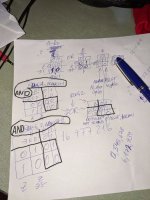The thing I don't get is that, once the pulse from coil B ceases (after one scan), and power is no longer transmitted via row 2, I cannot understand how row 1 transmits the power.
Forget row (branch) 3 for this, because B is 0 so it will always be 0 and will never affect the OR result.
So, without that last branch, the second rung is now
Z B Z
---] [------]/[------( )----
And since B is 0, the XIO/NC/--]/[--- of B is {NOT B}, which is {NOT 0}, which is 1, which reduces the rung to
Z Z
---] [---------( )---
So Z "seals" itself (Z) in as a 1 if it (Z) is a 1, and "seals" itself (Z) in as a 0 if it (Z) is a 0.
Also, be careful about thinking about PLC rungs as passing power or current or voltage: it's similar to that because the seminal idea PLCs decades was that all the maintenance techs and electricians, who were by definition able to read wiring schematics, could become diagnosticians or even programmers; I am not saying that is not intuitively and visually helpful, but if you get confused with PLC you have to drop back to bit logic i.e. ones and zeros.
Someone should shortly post the link for that "look for a 1/0" series of videos; that is 90 minutes that will change your entire approach to this.
See the image below:
- Rung 2 branch 1 is an AND of Z and notB,
- the result of which is a 2x2 box with three 0s and a 1;
- Rung 2 branch 2 is an AND of notZ and B,
- the result of which is a 2x2 box with three 0s and a 1,
- but in a different pattern than branch 1;
- the combining of the two branches is an OR,
- represented by the 2x2 box to the left, which is an OR-combination of
- 0 <= 0 OR 0, from the two top-left AND sub-boxes
- 0 <= 0 OR 0, from the two bottom-right AND sub-boxes
- 1 <= 1 OR 0, from the two bottom-left AND sub-boxes
- 1 <= 0 OR 1, from the two top-right AND sub-boxes . The two ANDs are on the left, their OR-combination is to the right.
The left column of the OR-result box is where B is 0, so notB is 1, so Z is a seal-in of itself, maintaining its value on all scans between B rising edges.






